Robert Strimban: A Life In Art

“I’m a happy person and I love life,” says 89-year-old Cutchogue artist Robert Strimban. “That’s the secret.”
Walking the lush, moss-carpeted grounds of his house and studio, the joy of his life and his art is evident everywhere. Bright aluminum sculptures of horses and figures play under the large trees. The studio is tucked away in the two-story garage, filled to the rafters with machinery and paints. The house is surrounded by wetlands; entry is over a bridge that covers a gurgling creek. It’s an artist’s paradise, a place Strimban knew he would always end up.
Growing up in Glen Cove, Strimban knew at 4 he wanted to be an artist. By 12 he had a show in Greenwich Village of his paintings. By his teens he had a scholarship to the Leonardo DaVinci Art School in New York. After that, he entered Pratt and the Art Students League.
When WWII broke out, he left school to join the Air Force and become a fighter-bomber.
“They wouldn’t let me finish the training though,” he says, “because I didn’t have 20/20 vision. But I did get to go all over the world—China, India—and see the wonderful art and artists in those countries. This was much more of an education to me than what I had been learning in school in New York. The colors and the craftsmanship were eye opening. I had been schooled on Realism, but by then it was the 1950s and abstraction was starting to become popular, it really encouraged me to develop my own style.”
Style is one thing; a job is another, so when Strimban left the service he took work in the Mad Men era of advertising on Madison Avenue.
“I did illustrations for every major magazine in New York—cover work and book covers too. I was good at it and enjoyed it until I started having bosses tell me what to do too much. I have the kind of personality that I don’t like to be ordered around, so I made the decision to become a fine artist full-time.”
Strimban and his wife, Irma, who he met at an art class and married in 1959, began moving around to have “adventures.” They bought a large farm upstate (“A crazy place that was; there was a cock-fighting pit in the basement!”) and an 1800s brownstone in Chelsea where their next-door neighbor was Louise Bourgeois. She became a friend and they had lively dinner parties together. She gifted the couple with several works of art. Another neighbor was the then-director of the Guggenheim Museum.
It was a burgeoning art community until a school requested to tear down several historic brownstones to make a playground. The Strimbans and many others took action, going down to City Hall and protesting. Four years of this activism resulted in achieving landmark status for the homes, thus saving dozens of them in the neighborhood.
Weary of the New York winters, he bought a house in the Florida Keys that was only accessible by small boats.
“I can’t believe my wife put up with that for 12 years,” he says chuckling. “We had no electricity and only rainwater to drink. She is such a trooper.”
Seeking space—and modern conveniences—the Strimbans moved to Cutchogue 20 years ago and settled into the home they still live in. He has been an active member of the East End Arts Council and has a new sculpture, “Lady Godiva,” on the grounds of the council office in Riverhead.. He exhibits frequently, particularly his latest work of paper sculptures. Another favorite series is of classic movie stars.
“My wife is a big film buff. She can remember every single actor in every movie we’ve ever seen. I did these paintings of The Marx Brothers, Gary Cooper, and Greta Garbo for her.”
Coming up on their 54th anniversary, Strimban reveals the secret to a lasting relationship.
“Well, it’s about love and animals,” he says. “We had no children but we’ve had many dogs over the years, that makes us happy.”
His other secret is no secret to anyone who lives on the East End. “I love living in nature, it’s a powerful force. Just the leaves growing and falling off the trees every year is a wonder to me.”



